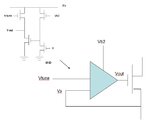bhl777
Full Member level 6
Hello everyone, I met a circuit configuration and want to understand how it works. It seems like Vtune has a linear relationship with Vx. Can anyone do some analysis for the attachment?
P.S: Do we need the outer circuit (the output of the triangle connects with the gate of another MOS) to analysis this shifter?
P.S: Do we need the outer circuit (the output of the triangle connects with the gate of another MOS) to analysis this shifter?

